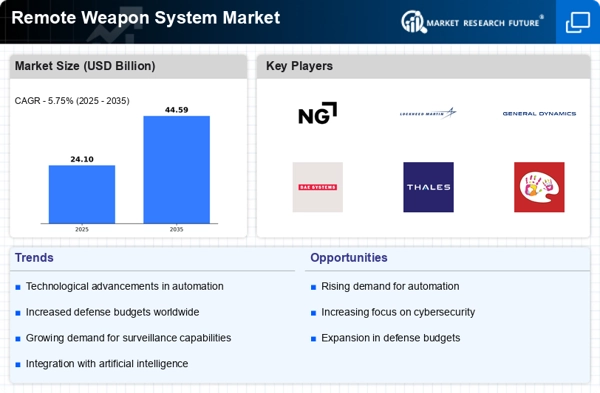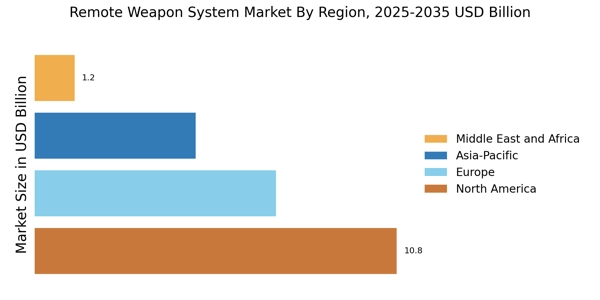The Remote Weapon System Market is currently characterized by a dynamic competitive landscape, driven by technological advancements and increasing defense budgets across various nations. Key players such as Northrop Grumman (US), Lockheed Martin (US), and BAE Systems (GB) are strategically positioned to leverage innovation and partnerships to enhance their market presence. Northrop Grumman (US) focuses on integrating artificial intelligence into its systems, which appears to be a significant differentiator in the market. Meanwhile, Lockheed Martin (US) emphasizes regional expansion and collaboration with allied nations to bolster its defense capabilities, thereby enhancing its competitive edge. BAE Systems (GB) is also investing in digital transformation initiatives, which may streamline operations and improve product offerings, collectively shaping a competitive environment that prioritizes technological superiority and strategic alliances.
The business tactics employed by these companies include localizing manufacturing and optimizing supply chains to enhance responsiveness to market demands. The Remote Weapon System Market is moderately fragmented, with several key players exerting considerable influence. This structure allows for a diverse range of offerings, yet the collective strategies of these major companies suggest a trend towards consolidation and collaboration, as they seek to address the complexities of modern warfare and defense requirements.
In August 2025, Northrop Grumman (US) announced a partnership with a leading technology firm to develop next-generation autonomous systems. This collaboration is poised to enhance their capabilities in remote weapon systems, particularly in the realm of AI and machine learning. The strategic importance of this move lies in its potential to position Northrop Grumman at the forefront of innovation, enabling them to offer advanced solutions that meet the evolving needs of military clients.
In September 2025, Lockheed Martin (US) secured a contract with a European nation for the supply of advanced remote weapon systems. This contract not only signifies Lockheed's commitment to expanding its international footprint but also highlights the growing demand for sophisticated defense solutions in Europe. The strategic implications of this contract may enhance Lockheed's reputation as a reliable partner in defense, potentially leading to further opportunities in the region.
In July 2025, BAE Systems (GB) unveiled a new line of remote weapon systems designed with sustainability in mind, incorporating eco-friendly materials and energy-efficient technologies. This initiative reflects a broader trend within the defense sector towards sustainability, which may resonate well with government clients increasingly focused on environmental considerations. The strategic importance of this development lies in BAE's ability to differentiate itself in a competitive market by aligning its offerings with contemporary values and expectations.
As of October 2025, the Remote Weapon System Market is witnessing trends such as digitalization, AI integration, and a heightened focus on sustainability. Strategic alliances are becoming increasingly pivotal, as companies recognize the need to collaborate to remain competitive. Looking ahead, it appears that competitive differentiation will evolve, shifting from traditional price-based competition to a focus on innovation, advanced technology, and supply chain reliability. This transition may redefine the parameters of success in the market, compelling companies to adapt and innovate continuously.


















Leave a Comment